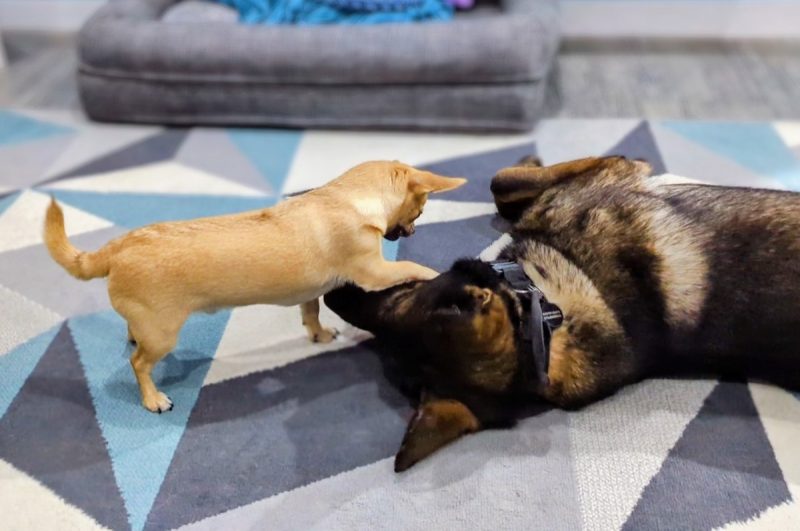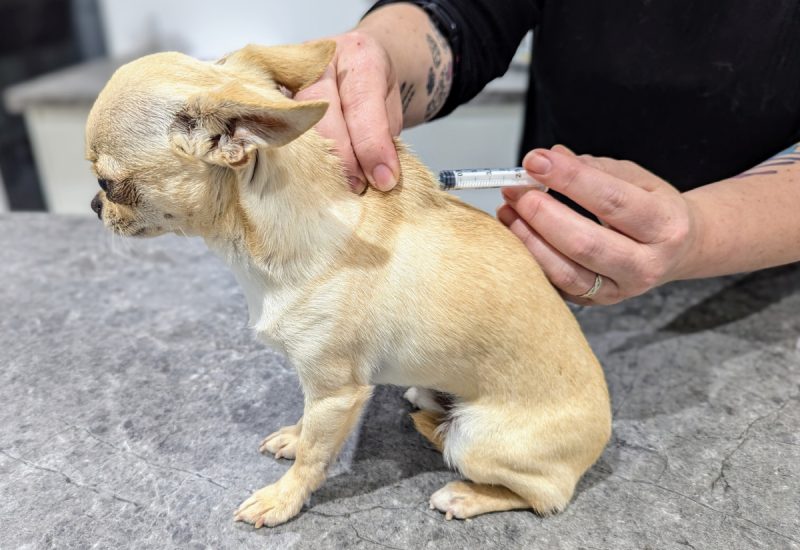Dr Karyn’s 10 Commandments For Successful Puppy Parenting (Part 2)
The post Dr Karyn’s 10 Commandments For Successful Puppy Parenting (Part 2) by Dr. Karyn Kanowski, BVSc MRCVS (Vet) appeared first on Dogster. Copying over entire articles infringes on copyright laws. You may not be aware of it, but all of these articles were assigned, contracted and paid for, so they aren’t considered public domain. However, we appreciate that you like the article and would love it if you continued sharing just the first paragraph of an article, then linking out to the rest of the piece on Dogster.com.
Hi, I’m Dr. Karyn! Read my introduction to learn more about me and my five funny dogs, Poppy, Bailey, Kodah, Ned, and Fred.
Last week, I shared part one of my 10 do’s and don’ts for raising a happy, well-adjusted puppy. If you missed it, click here to catch up.
Ready for the final five commandments? Read on:
These commandments are intended for puppies. Although some will absolutely apply to any new dog, some will be more difficult or even dangerous to implement with an adult rescue dog.
I have marked these with an ‘✽’.
The Final 5 Commandments for Successful Puppy Parenting:
6. Thou Shalt Not: Be Inconsistent
Puppy training is no place for good cop/bad cop. Although it is often inevitable that there will be a ‘soft’ parent and a disciplinarian, you need to present a united front in the early months. Consistency is one of the MOST important things to puppies and dogs. If they are allowed to do something one minute, then told off for doing it the next, you will cause stress and anxiety for your puppy.
You might let them in the bed or on the sofa when they’re older, but if you have decided that these areas are off limits for now, EVERYONE in the family must abide by those rules. Being inconsistent is unfair to your pup.
In our house, all the dogs must sit and wait to be told ‘okay’ before eating. It is a simple step, but it ensures that we have control over meals, which is important in a household of five dogs. This applies to every meal, no matter who is feeding them.

7. Thou Shalt: Learn the “NO!” bark
I think it’s been fairly well established that we females have been given the short end of the stick in many ways, and this also applies to dog training. The deeper male voice, which is more consistent with a canine growl, naturally elicits the attention and respect of our dogs, while the higher register of the female voice is more consistent with the vocalizations of play, excitement, or distress. This is why our dogs often, frustratingly, seem to pay more attention when the menfolk are talking.
How do we get around that? Practice your “no!” bark – make the word loud, deep, rumbling, and assertive. Not just for no, but when giving any command. It might feel like you’re being mean and gruff to bark out a word, but your dog won’t see it that way; you are just speaking their language and being clear that they need to listen. This is also an important one to teach children in the family, who are often the worst offenders of rule number 5 (repeating yourself).
8. Thou Shalt: Allow other pets to put your puppy in their place*
Socialization is extremely important for puppies, and part of that socialization is about learning manners. Other dogs, and even cats, know when they are dealing with a youngster, are usually more tolerant with them, and will pull their punches when it comes to telling them off. When an adult dog tells your puppy off, it is often with a loud bark and no bite, aimed at scaring your pup without hurting them. This is an important part of their training, so do not intervene unless the aggression is escalating.
Rough play-fighting is also important, usually involving lots of loud grumbles and squeals as young dogs learn how to play safely and how rough is too rough. Again, monitor this sort of interaction closely, but don’t interrupt unless noisy playing becomes proper fighting.

9. Thou Shalt: Take things away from your puppy*
When we raise our dogs right, we should be able to take a toy or food away from them without any grumbling, rumbling, or aggression, because
- they know that these behaviors are not acceptable around humans, and
- they are secure in the knowledge that we won’t deprive them of their food or toys permanently.
While it is a parent’s responsibility to teach their children not to take things from a dog or interrupt them when they are eating, distractions happen, and kids don’t always remember (or follow) the rules. Dogs, on the other hand, are more reliable when it comes to training.
An adult dog that is growling over food or toys is not to be trifled with, and that is a situation that is best addressed by a behaviorist. This sort of behavior in an 8-week-old puppy, however, should not be tolerated, and is where the “no!” bark comes in handy.
When your puppy is small, it is the perfect time to show them that our hands can touch their food bowl, and even take the bowl away, because we will always bring it back. Every mealtime, make a point of touching your puppy’s back, head, and face when they are eating, and take the bowl up once or twice, making sure to praise them when they don’t react.
The same goes for toys. If your puppy is becoming possessive over their toys, make sure that you can consistently take the toy from them, but once they have stopped protesting, return the toy to them so they know that you aren’t going to take it away forever. In most cases, a puppy isn’t going to be able to do too much damage if they try to take back a toy, but that doesn’t mean we shouldn’t be careful.
The aim here is to make sure your puppy understands that it is okay for people to touch their food and toys, and there is no need for them to guard them.
I’m not suggesting that we shouldn’t be teaching children to leave dogs alone when they are eating, just that we have a better chance of teaching dogs to be safe around children than teaching young kids to be safe around dogs. I’d prefer to train my dog to accept hands coming between them and their food, rather than hope that a child never tries it.
When it comes to other dogs, however, follow commandment #8 and let them teach your puppy the ‘dog rules.’

10. Thou Shalt: Vaccinate Your Puppy!
The prevalence of canine adverse vaccine reactions (mild to severe) is around 4 per 1000, with the number that die from vaccine reactions sitting at approximately 1 in 400,000.
- The fatality rate of Parvovirus is 90% (20-50% with treatment)
- The fatality rate of Rabies is almost 100%
- The fatality rate of Distemper is around 50%
And yet, more than half of recently surveyed dog owners said they are hesitant about vaccinating their dogs. Even if you decide not to continue with annual vaccinations after the first year, please, give your puppy a fighting chance and get them vaccinated! A healthy, vaccinated puppy can get out into the world and start socializing, which is a vital part of their training and development.

When choosing a name for your puppy, remember that you will likely need to be yelling it across a field or beach someday, so avoid anything too embarrassing or long-winded. And if you do favor a fancy name, consider a regular nickname to use for recall and training; preferably something short and sharp.
E.g.
- Name: Montgomery
- Nickname: Monty
Final Thoughts
Puppy training should be fun and enjoyable for everyone involved, but it also needs to be done correctly. Most of the things that dogs do ‘wrong’ are the result of us not being clear and consistent with what we have asked of them, and that has to start from the day they come into our homes. Dogs are most happy when they know what they are supposed to be doing and are getting praise for doing it. Believe me, it is worth feeling a little bit mean when setting some ground rules when you have a happy, confident dog whose behavior you don’t have to worry about.

- Read her previous article: Dr Karyn’s 10 Commandments For Successful Puppy Parenting (Part 1)
The post Dr Karyn’s 10 Commandments For Successful Puppy Parenting (Part 2) by Dr. Karyn Kanowski, BVSc MRCVS (Vet) appeared first on Dogster. Copying over entire articles infringes on copyright laws. You may not be aware of it, but all of these articles were assigned, contracted and paid for, so they aren’t considered public domain. However, we appreciate that you like the article and would love it if you continued sharing just the first paragraph of an article, then linking out to the rest of the piece on Dogster.com.